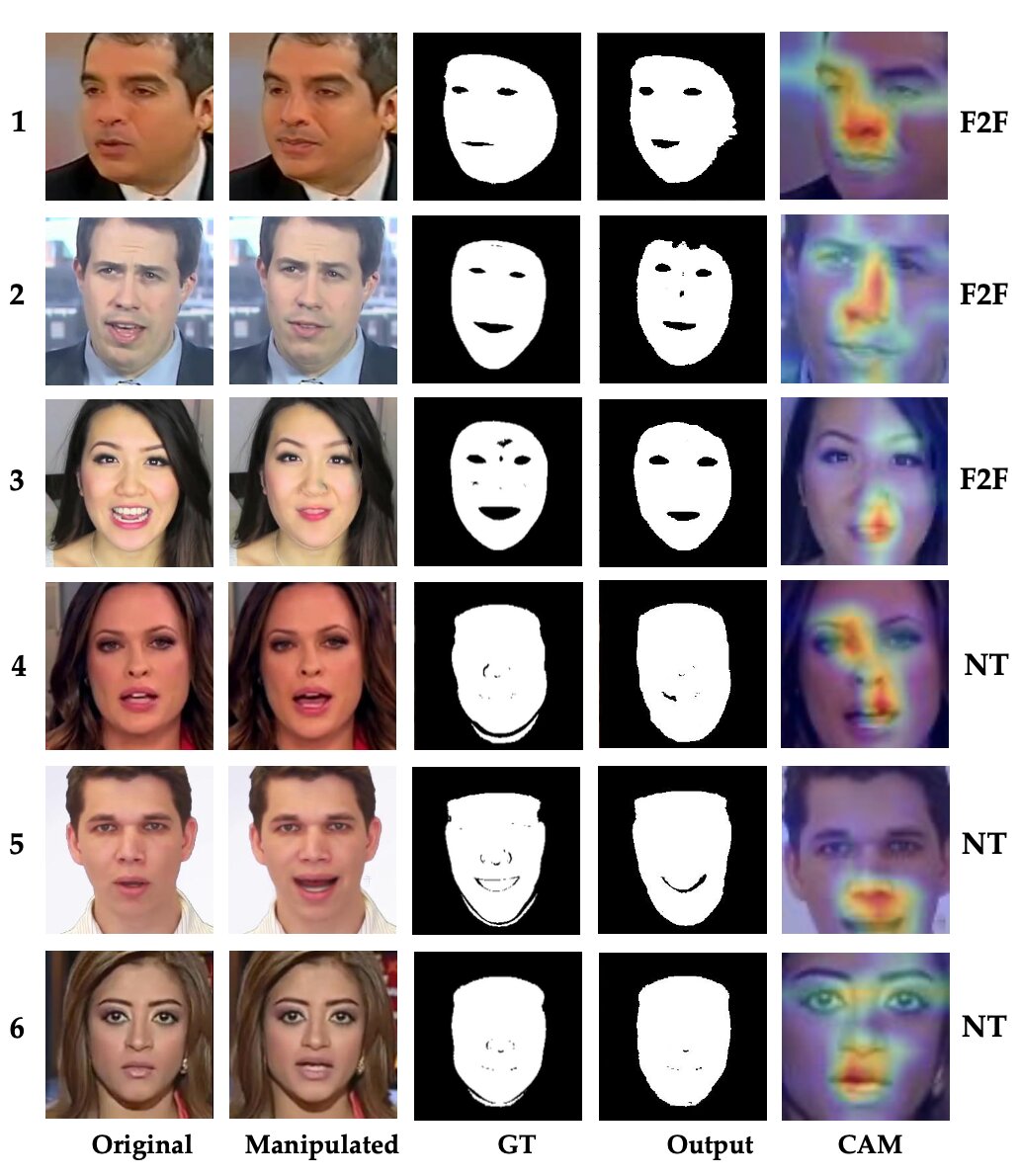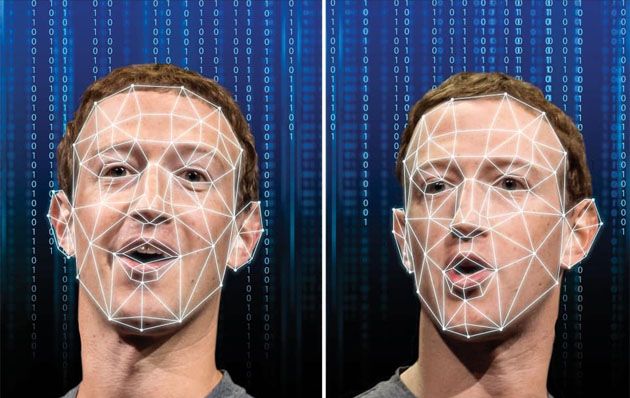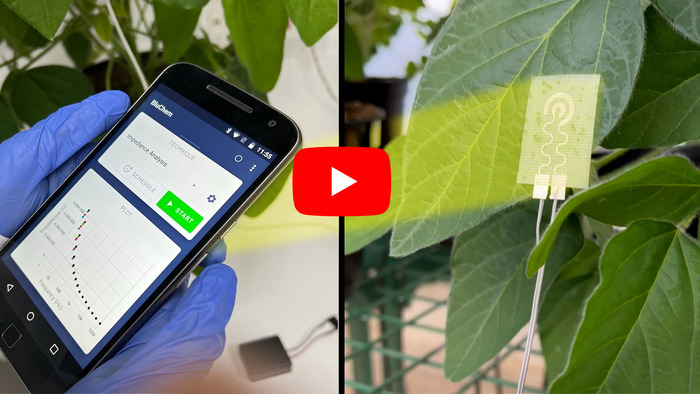
First and second columns show the original im- ages and manipulated ones respectively. The black and white images in the third column are corresponding bi- nary GT masks. Predicted masks (column 4) and generated CAMs (column 5) for manipulated images from Face2Face (row 1,2,3) and Neural-Textures (row 4,5,6) dataset.
(Mazaheri & Roy-Chowdhury, 2022)
Two-pronged technique detects manipulated facial expressions and identity swaps
Computer scientists at UC Riverside can detect manipulated facial expressions in deepfake videos with higher accuracy than current state-of-the-art methods. The method also works as well as current methods in cases where the facial identity, but not the expression, has been swapped, leading to a generalized approach to detect any kind of facial manipulation. The achievement brings researchers a step closer to developing automated tools for detecting manipulated videos that contain propaganda or misinformation.
Developments in video editing software have made it easy to exchange the face of one person for another and alter the expressions on original faces. As unscrupulous leaders and individuals deploy manipulated videos to sway political or social opinions, the ability to identify these videos is considered by many essential to protecting free democracies. Methods exist that can detect with reasonable accuracy when faces have been swapped. But identifying faces where only the expressions have been changed is more difficult and to date, no reliable technique exists.
“What makes the deepfake research area more challenging is the competition between the creation and detection and prevention of deepfakes which will become increasingly fierce in the future. With more advances in generative models, deepfakes will be easier to synthesize and harder to distinguish from real,” said paper co-author Amit Roy-Chowdhury, a Bourns College of Engineering professor of electrical and computer engineering.
The UC Riverside method divides the task into two components within a deep neural network. The first branch discerns facial expressions and feeds information about the regions that contain the expression, such as the mouth, eyes, or forehead, into a second branch, known as an encoder-decoder. The encoder-decoder architecture is responsible for manipulation detection and localization.
The framework, called Expression Manipulation Detection, or EMD, can both detect and localize the specific regions within an image that have been altered.
“Multi-task learning can leverage prominent features learned by facial expression recognition systems to benefit the training of conventional manipulation detection systems. Such an approach achieves impressive performance in facial expression manipulation detection,” said doctoral student Ghazal Mazaheri, who led the research.
The benchmark datasets for facial manipulation are based on expression and identity swap. One transfers the expressions of a source video onto a target video without changing the identity of the person in the target video. The other swaps two identities in a single video.
Experiments on two challenging facial manipulation datasets show EMD has better performance in detection of not only facial expression manipulations but also identity swaps. EMD accurately detected 99% of the manipulated videos.
Original Article: New method detects deepfake videos with up to 99% accuracy
More from: University of California Riverside
The Latest Updates from Bing News & Google News
Go deeper with Bing News on:
Deepfake videos
- A school principal faced threats after being accused of offensive language on a recording. Now police say it was a deepfake
The recording surfaced in January, sending shockwaves through Pikesville High School near Baltimore. It appeared the principal had been caught making racist and antisemitic comments. Now police are ...
- Baltimore officials address arrest in connection to recording of principal believed to be AI deepfake
Authorities arrested Pikesville High School’s former athletic director Dazhon Darien in connection with circulating a voice recording of the school’s principal Eric Eiswert, believed to be an ...
- Deepfake video falsely pitches dietary supplement as diabetes remedy
The Facebook video’s claim that Carlson and O’Neill discussed a dietary supplement that can cure diabetes and that it was made with Pfizer and approved by the FDA is Pants on Fire!
- Reid Hoffman interviewed his AI deepfake and it was pretty convincing
LinkedIn cofounder Reid Hoffman talked AI regulation, blitzscaling, and Seinfeld with his own deepfake — which also spoke in Klingon.
- Fact Check: Fox News video of Warren Buffett promoting bitcoin giveaway is a deepfake
A video of a Fox News broadcast showing American billionaire investor Warren Buffett promoting a bitcoin giveaway is fake, according to representatives for Fox and Buffett.
Go deeper with Google Headlines on:
Deepfake videos
[google_news title=”” keyword=”deepfake videos” num_posts=”5″ blurb_length=”0″ show_thumb=”left”]
Go deeper with Bing News on:
Expression Manipulation Detection
- Don't make these mistakes while flirting, your relationship will get spoiled
Flirting can be an exciting and enjoyable way to connect with someone you're interested in. However, it's essential to approach it w..|News Track ...
- Audio deepfakes and AI tricks threaten elections around the world
The rights of the people whose voices and images are being appropriated will need to be more seriously protected.
- Microsoft Joins Thorn and All Tech Is Human to enact strong child safety commitments for generative AI
Building on our longstanding commitment to online safety, Microsoft has joined Thorn, All Tech is Human, and other leading companies in their effort to prevent the misuse of generative AI technologies ...
- ‘Policymakers must clearly define what constitutes harmful deepfake content’
In the context of elections, deepfake could be used to spread false information, manipulate public opinion, and undermine the integrity of the electoral process ...
- Qtum Foundation Onlines 10,000 GPUs to Power Blockchain AI Ecosystem
Qtum Foundation is proud to announce its acquisition and onlining of 10,000 Nvidia GPUs to power AI initiatives. QtumTo view an enhanced version of this graphic, please visit: will include:Qtum ...
Go deeper with Google Headlines on:
Expression Manipulation Detection
[google_news title=”” keyword=”Expression Manipulation Detection” num_posts=”5″ blurb_length=”0″ show_thumb=”left”]










